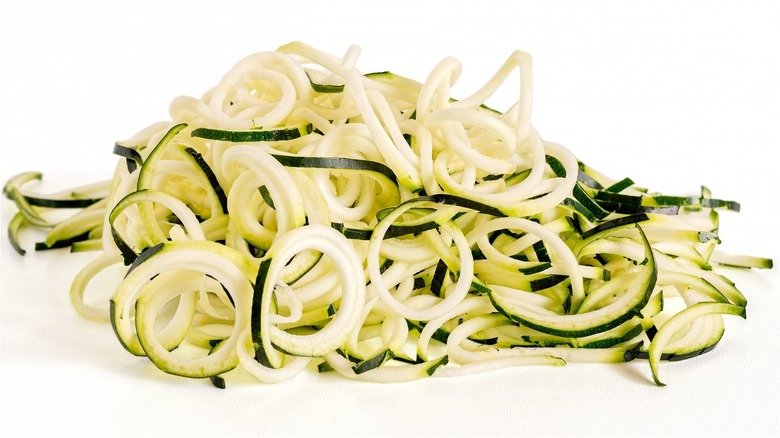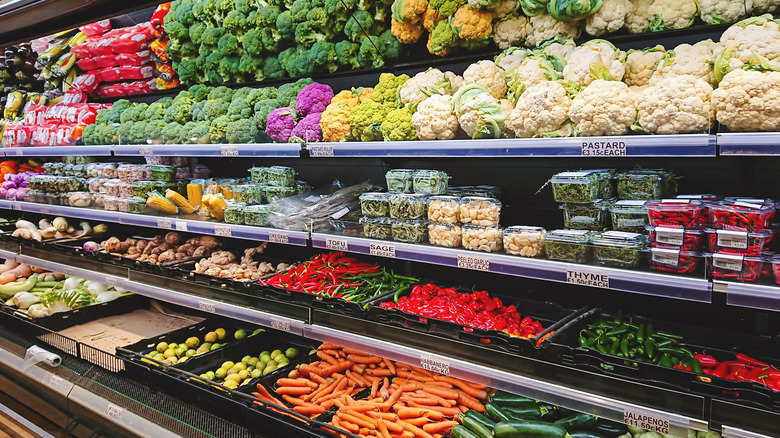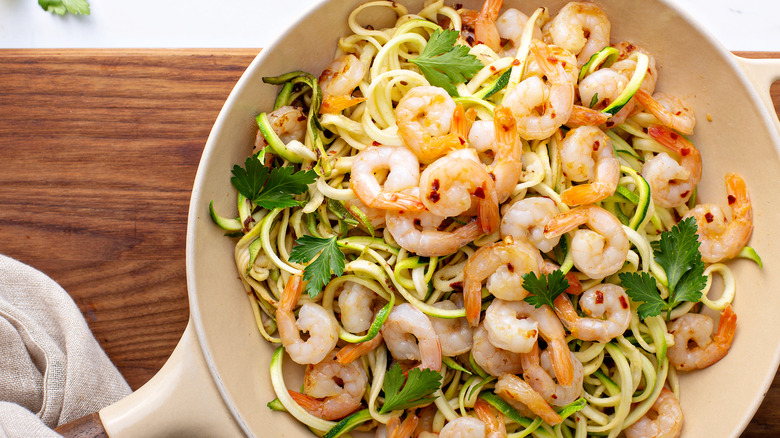Why You Might Be Glad You Bought Pre-Cut Zoodles At The Grocery Store
Lighter than pasta, zoodles are low-carb, gluten-free, and can be enjoyed on any diet, including Keto and Paleo. Mixed with pesto and vegetables, zoodles — noodle ribbons made from a zucchini squash — can be a low-calorie alternative to spaghetti. In place of pasta or served with a little olive oil, garlic, tomatoes, and basil), zoodles are a great way to sneak another serving of veggies into your daily meals.
You can buy them pre-cut from your supermarket, or make your own to stir into peanut sauce, sauté with vegetables, or toss in a salad. For a hearty main dish, add zoodles to proteins such as chicken, shrimp, meatballs, steak, salmon, or tofu. When the already healthy zucchini becomes a zoodle, it's a win-win. Fast, easy, low-cal, low-carb, and high-fiber, zoodles can help you get the recommended daily amount of produce. They are also a good source of vitamins A, C, B6, and potassium, according to Dr. Axe, a natural medicine practitioner and nutritionist.
If you're planning on cooking zoodles, you are left with one question: Should you make them yourself or purchase a pre-cut option from the grocery store?
Short on time? No spiralizer?
Fresh is better when it comes to taste, texture, price, and shelf life, but buying pre-cut zoodles in the grocery store is a close second. Saving time is the biggest factor in choosing store-bought over DIY. In the supermarket biz, pre-cut fruits and vegetables are called value-added, implying they have features that make them worthy of a higher price. So, you can take the time to buy and wash a zucchini, set up a tabletop spiralizer, crank out your own zucchini noodles, then let them dry in a colander – or you can buy the zoodles already cut in the grocery's refrigerated section.
On days when you can't imagine spiralizing a zucchini, it's good to have something that is ready to take home. Zoodles are also sold frozen or dried (boxed on the shelf), which require cooking. Aside from saving time, zoodles in the fridge may make it easier to make healthier choices. Whether you buy them, or make a batch to use for the next few days, it's convenient to have zoodles on hand. "Buying pre-prepped veggies can be a huge advantage, especially when you are in a hurry or making a recipe with a lot of ingredients," dietician Lauren Harris-Pincus told Allrecipes. Not all produce is a good candidate for pre-packaged buying, but zucchini noodles work well.
Do-it-yourself zoodles
Prefer to make your own? You may want to invest in a tabletop spiralizer. You can also use a simple peeler, mandolin or handheld spiralizer. Keep the peel on in order to retain the zucchini's fiber and color. For longer noodles, choose a straight zucchini rather than a curved one, advises Detroit Free Press. Go for one medium-sized zucchini for each serving. Bigger is not better since a large zucchini has less flavor.
Lightly salt your zoodles and let them sit in a colander to drain for 10 to 15 minutes. The salt will draw out the moisture and the paper towel will absorb it. Some cooks say to salt the noodles to soak up the water, while others say don't. Some say prepared zoodles can be frozen, others say freezing will change the texture. A tip from Easy Low Carb is to add thawed (and possibly mushy) zoodles to soups, stews, or sauces.
Fresh zucchini noodles will last up to five days sealed in an airtight container and stored in the refrigerator, per Inspiralized. Remove the amount of zoodles you need each night and add it to your dish. Laura Fuentes recommends sticking a paper towel in with the zucchini to absorb any moisture. She believes four days is the maximum duration that zucchini will retain its freshness.
If you don't have time or want to avoid mistakes everyone makes when making zucchini noodles, you can always fall back on pre-cut ones from the grocery store.


